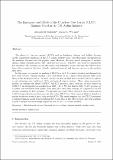The Emergence and Effects of the Ultra-Low Cost Carrier (ULCC) Business Model in the U.S. Airline Industry
Author(s)
Bachwich, Alexander; Wittman, Michael
Downloadulcc-paper-draft-revFINAL.pdf (436.0Kb)
Metadata
Show full item recordAbstract
The effects of “low-cost carriers” (LCCs) such as Southwest Airlines and JetBlue Airways on the competitive landscape of the U.S. airline industry have been thoroughly documented in the academic literature and the popular press. However, the more recent emergence of another distinct airline business model—the “ultra-low-cost carrier” (ULCC)—has received considerably less attention. By focusing on cost efficiencies and unbundled service offerings, the ULCCs have been able to undercut the fares of both traditional network and low-cost carriers in the markets they serve. In this paper, we conduct an analysis of ULCCs in the U.S. aviation industry and demonstrate how these carriers’ business models, costs, and effects on air transportation markets differ from those of the traditional LCCs. We first describe the factors that have enabled ULCCs to achieve a cost advantage over traditional LCCs and network legacy carriers. Then, using econometric models, we examine the effects of ULCC and LCC presence, entry, and exit on base airfares in 3,004 U.S. air transportation markets from 2010 – 2015. We find that in 2015, ULCC presence in a market was associated with market base fares 21% lower than average, as compared to an 8% average reduction for LCC presence. We also find that while ULCC and LCC entry both result in a 14% average reduction in fares one year after entry, ULCCs are three times as likely to abandon a market within two years of entry than are the LCCs. The results suggest that the ULCCs represent a distinct business model from traditional LCCs and that as the ULCCs grow, they will continue to play a unique and increasingly important role in the U.S. airline industry.
Date issued
2016-10-19Keywords
low-cost carriers, ultra-low-cost carrier, air transportation, airline business models, market entry, market presence, airline costs